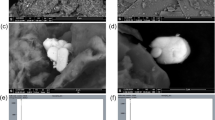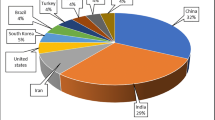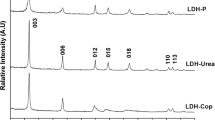Abstract
Interlayer sodium ions of montmorillonite were exchanged with hydroxy-bismuth polycations which were prepared from bismuth perchlorate solutions by the addition of NaOH. Assuming the charge density of the silicate layer to be unchanged, the compositions of the polycations involved in the exchange can be estimated from the amount of bismuth taken up by the montmorillonite and from the ignition loss between 110° and 800°C. The derived compositions are near [Bi6(OH)16]2+ irrespective of the ratio of OH:Bi in the perchlorate solution. The basal spacing of the hydroxy-bismuth montmorillonites is about 16 Å at 110°C, which corresponds to that of hydroxy-chromium montmorillonite having a high surface area of about 250 m2/g. The surface areas of the hydroxy-bismuth montmorillonites, however, are less than 80 m2/g.
Резюме
Межслойные натриевые ионы монтмориллонита были заменены поликатионами окси-висмута, которые приготовлялись из растворов висмутового перхлората добавлением ИаОН. Предполагая, что плотность зарядов силикатного слоя не должна изменяться, состав поликатионов, вовлеченных в обмен, можно определить по количеству висмута принятого монтмориллонитом и из потерь прокаливания при температурах от 110° до 800°C. Полученные составы близки [Bi6(OH)16]2+ независимо от отношения OH:Bi в перхлоратовых растворах. Основной промежуток оксивисму-товых монтмориллонитов равен примерно 16 Å при 110°С, который соответствует промежутку оксихромового монтмориллонита, имеющего большую поверхностную площадь, примерно 250 м2/г. Поверзностные площади висмутовых монтмориллонитов, однако, меньше 80 м2/г. [N.R.]
Resümee
Zwischenschichtnatrium von Montmorillonit wurde gegen Hydroxy-Wismut-Polykationen ausgetauscht, die durch die Zugabe von NaOH aus Wismutperchloratlösungen hergestellt wurden. Unter der Annahme einer unveränderten Ladungsdichte der Silikatlagen kann man die Zusammensetzung der am Austausch beteiligten Polykationen aus der Wismutmenge, die durch den Montmorillonit aufgenommen wird, und aus dem Glühverlust zwischen 110° und 800°C abschätzen. Die abgeleiteten Zusammensetzungen sind etwa [Bi6(OH)16]2+, unabhängig vom OH:Bi-Verhältnis in der Perchloratlösung. Der Basisabstand der Hydroxy-Wismut-Montmorillonite beträgt bei 110°C etwa 16 Å. Dies entspricht dem von Hydroxy-Chrom-Montmorillonit, der eine große Oberfläche von etwa 250 m2/g hat. Die Oberflächen der Hydroxy-Wismut-Montmorillonite sind dagegen unter 80 m2/g. [U.W.]
Résumé
Des ions de sodium interfeuillets de montmorillonite ont été échangés avec des polycations hydroxy-bismuth qui avaient été préparés à partir de solutions de perchlorate par addition de NaOH. Si l’on suppose que la densité de charge de la couche silicée demeure inchangée, les compositions des polycations concernés par l’échange peuvent être estimées par la quantité de bismuth prise par la montmorillonite et par la perte à l’ignition entre 110° et 800°C. Les compositions derivées sont près de [Bi6(OH)16]2+ de manière irrespective de la proportion de OH:Bi dans la solution de perchlorate. L’espacement basal des montmorillonites hydroxy-bismuth est à peu près 16 Å à 110°C, ce qui correspond à celui de la montmorillonite hydroxy-chromium ayant une aire de surface élevée d’approximativement 250 m2/g. Les aires de surface des montmorillonites hydroxy-bismuth sont cependant moins que 80 m2/g. [D.J.]
Similar content being viewed by others
References
Asmus, A. (1954) Photometrische Wismutbestimmung in Blei-Zinnlegierungen: Z. Anal. Chem. 142, 255–266.
Baes, C. F., Jr. and Mesmer, R. E. (1976) The Hydrolysis of Cations: John Wiley, New York, 375–383.
Brindley, G. W. and Sempels, R. E. (1977) Preparation and properties of some hydroxy-aluminum beidellites: Clay Miner. 12, 229–237.
Brindley, G. W. and Yamanaka, S. (1979) A study of hydroxy-chromium montmorillonites and the form of the hydroxy-chromium polymers: Amer. Mineral. 64, 830–835.
Lahav, N., Shani, U., and Shabtai, J. (1978) Cross-linked smectites. I. Synthesis and properties of hydroxy-aluminum montmorillonite: Clays & Clay Minerats 26, 107–115.
Levy, H. A., Danford, M. D., and Agron, P. A. (1959) X-ray diffraction study of bismuth polymer in aqueous Perchlorate solution: J. Chem. Phys. 31, 1458–1461.
Rich, C. I. (1968) Hydroxy interlayers in expansible layer silicates: Clays & Clay Minerals 16, 15–30.
Veith, J. A. (1978) Selectivity and adsorption capacity of smectite and vermiculite for aluminum of varying basicity: Clays & Clay Minerals 26, 45–50.
Yamanaka, S. and Brindley, G. W. (1978) Hydroxy-nickel interlayering in montmorillonite by titration method: Clays & Clay Minerals 26, 21–24.
Yamanaka, S. and Brindley, G. W. (1979) High surface area solids obtained by reaction of montmorillonite with zirconyl chloride: Clays & Clay Minerals 27, 119–124.
Author information
Authors and Affiliations
Rights and permissions
About this article
Cite this article
Yamanaka, S., Yamashita, G. & Hattori, M. Reaction of Hydroxy-Bismuth Polycations with Montmorillonite. Clays Clay Miner. 28, 281–284 (1980). https://doi.org/10.1346/CCMN.1980.0280406
Received:
Accepted:
Published:
Issue Date:
DOI: https://doi.org/10.1346/CCMN.1980.0280406




